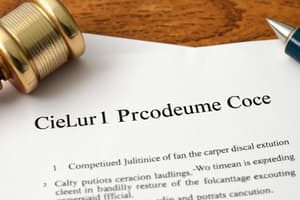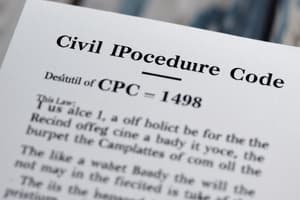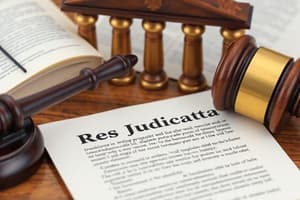Podcast
Questions and Answers
How do the powers conferred by Sections 122, 126, and 127 of the CPC on High Courts interact with the High Court's inherent rule-making authority under Article 215 of the Constitution?
How do the powers conferred by Sections 122, 126, and 127 of the CPC on High Courts interact with the High Court's inherent rule-making authority under Article 215 of the Constitution?
- Sections 122, 126, and 127 and Article 215 operate independently, with Sections addressing procedural rules and Article 215 pertaining to administrative matters.
- Article 215 solely governs the rule-making powers of High Courts, rendering Sections 122, 126, and 127 obsolete and unenforceable.
- Sections 122, 126, and 127 delineate exclusive powers, preempting any inherent authority of High Courts under Article 215 to frame rules.
- Sections 122, 126, and 127 supplement the inherent powers of High Courts under Article 215, providing statutory mechanisms for rule-making while recognizing the court's broader constitutional mandate. (correct)
In a complex case involving both original and appellate jurisdiction, how does a chartered High Court's handling of the case differ from that of a High Court lacking original jurisdiction when procedural matters arise that are not explicitly covered by the CPC?
In a complex case involving both original and appellate jurisdiction, how does a chartered High Court's handling of the case differ from that of a High Court lacking original jurisdiction when procedural matters arise that are not explicitly covered by the CPC?
- Chartered High Courts can invoke their broader inherent powers to fill procedural gaps, while other High Courts are limited to the explicit provisions of the CPC. (correct)
- Both types of High Courts are equally bound by the CPC and cannot deviate regardless of their jurisdictional differences.
- Chartered High Courts must strictly adhere to CPC provisions, whereas other High Courts can rely on inherent powers to address procedural gaps.
- Chartered High Courts can create entirely new procedures, while other High Courts are restricted to interpreting existing CPC rules.
A plaintiff presents a plaint that fulfills the basic requirements but strategically omits certain facts that, if included, would reveal a potential jurisdictional issue. What recourse does the defendant have, and how should the court approach this situation?
A plaintiff presents a plaint that fulfills the basic requirements but strategically omits certain facts that, if included, would reveal a potential jurisdictional issue. What recourse does the defendant have, and how should the court approach this situation?
- The court must reject the plaint *suo moto* upon noticing the omission, as it is the court's duty to ensure proper jurisdiction is established.
- The defendant is estopped from challenging jurisdiction because the plaintiff has already invoked it.
- The defendant can only challenge the jurisdiction after the trial has commenced, as the court must presume the plaint is truthful at the outset.
- The defendant can file an application under Order 7 Rule 10, requesting the return of the plaint to be presented in the correct jurisdiction, arguing that the omission constitutes a deliberate attempt to mislead the court. (correct)
How does the interplay between Section 26 and Orders 1-7 of the CPC impact the validity of a suit if the plaint is presented without adhering to the specific procedural guidelines outlined in Orders 1-7?
How does the interplay between Section 26 and Orders 1-7 of the CPC impact the validity of a suit if the plaint is presented without adhering to the specific procedural guidelines outlined in Orders 1-7?
In a situation where both Section 104 and Order 43 provide for appealable orders, which principle governs if there is an apparent conflict or ambiguity between the two regarding a specific type of order?
In a situation where both Section 104 and Order 43 provide for appealable orders, which principle governs if there is an apparent conflict or ambiguity between the two regarding a specific type of order?
A litigant, after failing in a first miscellaneous appeal under Section 104 and Order 43, attempts to invoke Article 226 of the Constitution. What factors will a High Court consider when determining the maintainability of the Article 226 petition in this context?
A litigant, after failing in a first miscellaneous appeal under Section 104 and Order 43, attempts to invoke Article 226 of the Constitution. What factors will a High Court consider when determining the maintainability of the Article 226 petition in this context?
In a situation where a suit satisfies the monetary threshold for commercial disputes but involves a complex mix of commercial and non-commercial elements, how does a court determine whether it falls under the jurisdiction of the Commercial Courts Act?
In a situation where a suit satisfies the monetary threshold for commercial disputes but involves a complex mix of commercial and non-commercial elements, how does a court determine whether it falls under the jurisdiction of the Commercial Courts Act?
How does the mandatory timeline prescribed in the Commercial Courts Act for the filing of a written statement interact with the court's inherent power to regulate its own procedure to achieve justice?
How does the mandatory timeline prescribed in the Commercial Courts Act for the filing of a written statement interact with the court's inherent power to regulate its own procedure to achieve justice?
What is the rationale behind the Limitation Act's principle of protecting the vigilant, and how does this principle interact with equitable considerations when a delay is caused by circumstances genuinely beyond a party's control?
What is the rationale behind the Limitation Act's principle of protecting the vigilant, and how does this principle interact with equitable considerations when a delay is caused by circumstances genuinely beyond a party's control?
When a suit is filed beyond the limitation period, but the defendant fails to raise the objection, what is the court's responsibility, and what legal principle underpins this?
When a suit is filed beyond the limitation period, but the defendant fails to raise the objection, what is the court's responsibility, and what legal principle underpins this?
How do Sections 6-8 of the Limitation Act on legal disability interact with the general principles of limitation when a plaintiff suffers from multiple disabilities consecutively?
How do Sections 6-8 of the Limitation Act on legal disability interact with the general principles of limitation when a plaintiff suffers from multiple disabilities consecutively?
A litigant mistakenly files a suit in a consumer forum instead of a civil court due to a genuine misunderstanding of the applicable law. How does Section 14 of the Limitation Act apply, and what conditions must be met for the litigant to benefit from it?
A litigant mistakenly files a suit in a consumer forum instead of a civil court due to a genuine misunderstanding of the applicable law. How does Section 14 of the Limitation Act apply, and what conditions must be met for the litigant to benefit from it?
In a complex commercial dispute, a party includes extensive factual details in their pleading. How does a court differentiate between 'material facts' and 'evidential facts' in such a scenario, and what are the implications of this distinction?
In a complex commercial dispute, a party includes extensive factual details in their pleading. How does a court differentiate between 'material facts' and 'evidential facts' in such a scenario, and what are the implications of this distinction?
A plaint includes a question of law without a clear nexus to specific material facts. What is the court's likely response, and how does this align with the principles of pleading?
A plaint includes a question of law without a clear nexus to specific material facts. What is the court's likely response, and how does this align with the principles of pleading?
In a dispute where the cause of action arises in multiple locations, how does a court determine which territorial jurisdiction is appropriate, especially when the defendant resides in a different location?
In a dispute where the cause of action arises in multiple locations, how does a court determine which territorial jurisdiction is appropriate, especially when the defendant resides in a different location?
What happens when a special statute confers exclusive jurisdiction on a particular tribunal, but a suit involving the same subject matter is filed in a civil court governed by the CPC?
What happens when a special statute confers exclusive jurisdiction on a particular tribunal, but a suit involving the same subject matter is filed in a civil court governed by the CPC?
How does the principle of res judicata interact with the provisions for rejection of a plaint under Order 7 Rule 11, particularly when a prior suit on the same cause of action was dismissed for default?
How does the principle of res judicata interact with the provisions for rejection of a plaint under Order 7 Rule 11, particularly when a prior suit on the same cause of action was dismissed for default?
A plaint is presented to a court lacking pecuniary jurisdiction, and the defendant fails to raise an objection. What is the court's duty in this situation, and what legal principles guide its actions?
A plaint is presented to a court lacking pecuniary jurisdiction, and the defendant fails to raise an objection. What is the court's duty in this situation, and what legal principles guide its actions?
How does the distinction between 'lack of jurisdiction' and 'jurisdictional error' influence the court's handling of a case where a plaint is filed with an undervaluation of the suit's subject matter?
How does the distinction between 'lack of jurisdiction' and 'jurisdictional error' influence the court's handling of a case where a plaint is filed with an undervaluation of the suit's subject matter?
In a suit where the plaint could be rejected under multiple clauses of Order 7 Rule 11, how should the court proceed, and what considerations guide its decision-making process?
In a suit where the plaint could be rejected under multiple clauses of Order 7 Rule 11, how should the court proceed, and what considerations guide its decision-making process?
How do preliminary issues under Order 14, Rule 2(2) interact with the principles of natural justice when a court decides to dismiss a suit based on a preliminary issue without allowing the parties to fully present their evidence on other issues?
How do preliminary issues under Order 14, Rule 2(2) interact with the principles of natural justice when a court decides to dismiss a suit based on a preliminary issue without allowing the parties to fully present their evidence on other issues?
What is the significance of the relationship between pleadings, issues, evidence, and judgment in the context of appellate review, and how does a deficiency in the initial pleading affect the appellate court's assessment?
What is the significance of the relationship between pleadings, issues, evidence, and judgment in the context of appellate review, and how does a deficiency in the initial pleading affect the appellate court's assessment?
How do the supplementary remedies of injunction, receiver, and commission under Section 94 of the CPC interact with the court's inherent powers to achieve justice, particularly in situations not explicitly covered by the CPC?
How do the supplementary remedies of injunction, receiver, and commission under Section 94 of the CPC interact with the court's inherent powers to achieve justice, particularly in situations not explicitly covered by the CPC?
How does the "prima facie case" requirement interact with the "balance of convenience" and "irreparable loss" principles when a court considers granting an injunction?
How does the "prima facie case" requirement interact with the "balance of convenience" and "irreparable loss" principles when a court considers granting an injunction?
In what scenarios is the appointment of a receiver most appropriate, considering the receiver's role and the potential impact on the parties involved?
In what scenarios is the appointment of a receiver most appropriate, considering the receiver's role and the potential impact on the parties involved?
How does the compulsory pre-institutional mediation under Section 12A of the Commercial Courts Act interact with the fundamental principles of party autonomy and freedom of contract?
How does the compulsory pre-institutional mediation under Section 12A of the Commercial Courts Act interact with the fundamental principles of party autonomy and freedom of contract?
Under what circumstances can a commercial court grant a summary judgment, and what safeguards are in place to protect the defendant's right to a fair trial?
Under what circumstances can a commercial court grant a summary judgment, and what safeguards are in place to protect the defendant's right to a fair trial?
How does a case management hearing in commercial courts differ from traditional pre-trial procedures in CPC, and what is the legal basis for this difference?
How does a case management hearing in commercial courts differ from traditional pre-trial procedures in CPC, and what is the legal basis for this difference?
How should a court reconcile the conflicting timelines in CPC and the Commercial Courts Act, particularly when determining the consequences of failing to adhere to the prescribed deadlines?
How should a court reconcile the conflicting timelines in CPC and the Commercial Courts Act, particularly when determining the consequences of failing to adhere to the prescribed deadlines?
Flashcards
Rights and Remedies
Rights and Remedies
Rights and remedies are inseparable aspects of a legal issue.
CPC Components
CPC Components
The CPC contains 151 sections, 41 orders, and associated rules.
First Codified CPC
First Codified CPC
The first codified CPC was enacted in 1859, featuring 388 sections.
Section vs. Order/Rule
Section vs. Order/Rule
Signup and view all the flashcards
High Court Rule-Making Powers
High Court Rule-Making Powers
Signup and view all the flashcards
High Courts Independence
High Courts Independence
Signup and view all the flashcards
Jurisdiction Types
Jurisdiction Types
Signup and view all the flashcards
Original Jurisdiction
Original Jurisdiction
Signup and view all the flashcards
Chartered High Courts
Chartered High Courts
Signup and view all the flashcards
Suit Institution
Suit Institution
Signup and view all the flashcards
Suit Procedure Orders
Suit Procedure Orders
Signup and view all the flashcards
Sections & Orders
Sections & Orders
Signup and view all the flashcards
Amendment Authority
Amendment Authority
Signup and view all the flashcards
Appealable Orders
Appealable Orders
Signup and view all the flashcards
Appeal Types
Appeal Types
Signup and view all the flashcards
Appeal Failure
Appeal Failure
Signup and view all the flashcards
Commercial Court
Commercial Court
Signup and view all the flashcards
Timeline Difference
Timeline Difference
Signup and view all the flashcards
Limitation Act Principle
Limitation Act Principle
Signup and view all the flashcards
Limitation Act Effect
Limitation Act Effect
Signup and view all the flashcards
Delay Condonation
Delay Condonation
Signup and view all the flashcards
Legal Disability
Legal Disability
Signup and view all the flashcards
Section 14 Benefit
Section 14 Benefit
Signup and view all the flashcards
What is Pleading?
What is Pleading?
Signup and view all the flashcards
Plaint Elements
Plaint Elements
Signup and view all the flashcards
Material Facts
Material Facts
Signup and view all the flashcards
Material vs. Evidential
Material vs. Evidential
Signup and view all the flashcards
Legal Q's in Plaint
Legal Q's in Plaint
Signup and view all the flashcards
Jurisdiction Types
Jurisdiction Types
Signup and view all the flashcards
Territorial factors
Territorial factors
Signup and view all the flashcards
Study Notes
- Rights and remedies are interconnected.
- The Civil Procedure Code (CPC) contains 151 sections and 41 orders with rules.
- The first codified CPC was enacted in 1859, featuring 388 sections.
- Substantive provisions in the CPC are sections that remain unchanged, while procedural provisions are orders/rules that can be amended as needed.
- High Courts can frame orders and rules via Sections 122, 126, and 127, in line with the state government.
- High Courts are not bound by the CPC when creating their own rules due to their constitutional status and function as Courts of Record.
- Courts can have original and appellate jurisdiction.
- Original jurisdiction is the power of a court to hear a civil suit initially.
- Chartered High Courts in India have both original and appellate jurisdiction.
- Suits are initiated through plaint presentation as per Section 26 of the CPC.
- Orders 1-7 detail the procedure for instituting a suit.
- Sections in the CPC are substantive, while orders and rules apply the principles.
- Only the legislature can change sections, but High Courts can change orders and rules.
- Appealable orders are covered in Section 104 and Order 43.
- Appeals can be made against decrees or intermediate orders.
- If a first miscellaneous appeal fails, no second appeal is allowed, but Article 226 can be used for challenges.
- Commercial Courts require matters to be commercial in nature with a suit value over 3 lakhs.
- Timelines are directory in the CPC but mandatory in the Commercial Courts Act.
- The Limitation Act protects those vigilant about their rights, not those who neglect them.
- The Limitation Act bars the remedy but not the right before a civil court.
- Section 5 of the Limitation Act allows courts to condone delays in applications, revisions, or appeals, but not original suits.
- Sections 6-8 of the Limitation Act address legal disabilities such as minority or mental disorder.
- Section 14 of the Limitation Act applies when there is a lack of jurisdiction, allowing exclusion of time spent in the wrong forum from the limitation period.
- Pleading includes the plaint (plaintiff) and written statements (respondent).
- A plaint must include the parties involved, the court's jurisdiction, the cause of action, and the relief sought.
- Material facts in pleading are essential for establishing the cause of action.
- Material facts establish the cause of action, while evidential facts prove the main facts.
- Pleadings generally cannot include law, but can have mixed questions of fact and law.
Types of Jurisdiction
- Jurisdiction is based on subject matter, territory, and pecuniary value.
- Territorial jurisdiction is based where the cause of action occurs or where the defendant resides.
- Special statutes dictating jurisdiction take precedence over the CPC.
- Filing a suit in the wrong jurisdiction allows the defendant to apply under Order 7 Rule 10 for plaint return.
- Lack of jurisdiction means the court cannot hear the suit, while jurisdictional error means incorrect exercise of power.
- Order 7 Rule 11 allows plaint rejection due to institutional defects.
- Plaint return (Order 7 Rule 10) is due to lack of jurisdiction, while rejection (Order 7 Rule 11) is due to jurisdictional error.
- Section 3 of the Limitation Act mandates suit dismissal if filed after the limitation period, even if the defendant does not raise the issue.
- An issue identifies the dispute's subject matter for trial adjudication.
- Issues are framed based on pleadings in the plaint and written statement under Order 14.
- Preliminary issues concern the case's maintainability and are decided before other issues.
- Order 14, Rule 2(2) requires courts to first decide preliminary issues related to maintainability and whether the cognizance is barred by any law.
- The final judgment relies on evidence, which is based on issues, which are based on pleadings.
- Miscellaneous proceedings are supplementary to protect the suit's subject matter and ensure justice.
- Injunction, receiver, and commission are the main supplementary remedies under Section 94 of the CPC.
- Principles for granting an injunction include a prima facie case, balance of convenience, and irreparable loss.
- A decree determines the parties' rights conclusively, while an order does not and is filed to protect the subject matter.
- A receiver manages the business's affairs during the suit as a court-appointed officer.
Commercial Court Act Details
- Pre-institutional mediation (Section 12A) is compulsory in commercial disputes.
- Summary judgment in commercial courts occurs when the plaintiff has no chance of winning based on their documents.
- Case management hearing involves the Court setting fixed timelines for witness examination with consent from both parties.
- A written statement in the CPC must be filed within 30-90 days, but in the Commercial Courts Act, it's 30-120 days with no extension beyond 120 days.
Studying That Suits You
Use AI to generate personalized quizzes and flashcards to suit your learning preferences.




